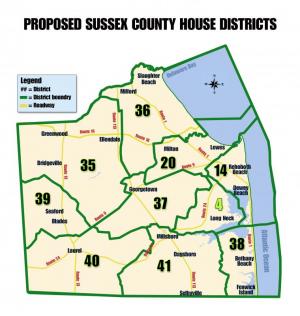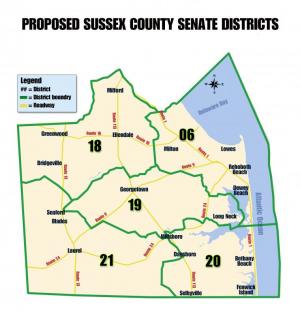Sussex gets new House district under proposal
Sussex County has a new House district under a revised legislative map released Oct. 13.
Under the proposal, the 4th District seat held by Rep. Gerald Brady, D-Wilmington, moves to a recently carved-out section of Long Neck. The district is mostly made up from the area that was in the 37th District, but it also has parts of the 41st, 38th, and 14th districts.
The new Sussex district would increase the number of House seats for Sussex County from nine to 10, and decrease the number of districts in Wilmington by one. The total number of House seats remains at 41.
Brady had already said he would not run for re-election, after receiving backlash for emails that contained Asian and sexist slurs. Based on the latest census data, some Wilmington districts were below the 5 percent deviation allowed for district populations, and Sussex County districts were above it. Speaker of the House Rep. Pete Schwartzkopf, D-Rehoboth Beach, said last summer that Sussex would probably be getting a new district.
The new district reflects the burgeoning population along Delaware’s southern coast.
Delaware’s redistricting process is set to continue with public hearings to be held Oct. 18, 19 and 21.
The hearings will allow the public to offer comments on draft maps that have been drawn with new lines for legislative districts. By law, the Legislature must approve new maps by Nov. 8 for candidates to file for the 2022 election.
The number of Senate seats remains the same at 21.
In Sussex County, boundary lines have been tweaked a bit, with the 6th District line moving north to include Slaughter Beach, an area once part of the 18th District. The 19th District line no longer extends to the state’s western boundary, but is more centrally located.
All Sussex districts, except the 18th, have a standard population above 47,140 – the number derived from taking Delaware’s population of 989,940 and dividing it by 21.
The 6th District was about 3 percent higher, and districts 9-21 were pushing 5 percent higher – the maximum deviation amount generally required.
Conversely, in upstate Senate districts, population declines show district numbers pushing -5 percent of the deviation for districts 2 and 7. Senate District 8 had about a -3 percent deviation and District 9 had a -2.75 percent deviation.
The Senate will hold a virtual redistricting hearing at 6 p.m., Tuesday, Oct. 19, and an in-person hearing at 6 p.m., Thursday, Oct. 21.
A House redistricting hearing will be held at 6 p.m., Monday, Oct. 18, in a hybrid virtual and in-person format.
Legislative leaders will introduce the final maps as a Senate bill at the end of October. There will be one bill for all 62 legislative districts, detailing the boundaries of each district. The General Assembly will convene Monday, Nov. 1, for a special session to consider the final redistricting bill. If passed by the House and Senate, it will go to Gov. John Carney for his signature.
The new legislative districts will take effect for the 2022 general election. Candidates in that election must reside in the new districts, and immediately following the Nov. 8, 2022 election, legislators will begin representing constituents within the new district lines.
Melissa Steele is a staff writer covering the state Legislature, government and police. Her newspaper career spans more than 30 years and includes working for the Delaware State News, Burlington County Times, The News Journal, Dover Post and Milford Beacon before coming to the Cape Gazette in 2012. Her work has received numerous awards, most notably a Pulitzer Prize-adjudicated investigative piece, and a runner-up for the MDDC James S. Keat Freedom of Information Award.























































